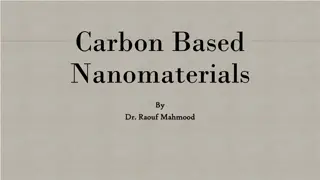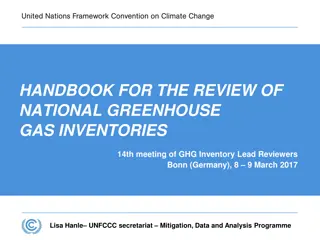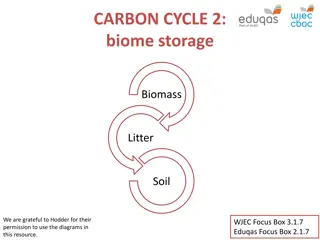Application of CMS-Flux System for Carbon Flux Inventories Evaluation
Preparation for the global CMS Flux system integration with US forest and agricultural carbon inventory data to quantify uncertainties and enhance inventory-relevant flux estimates. The project aims to evaluate the utility of CMS-Flux-NA system for top-down assessment of US agricultural and forest CO2 emissions inventories through observation-based evaluations and regional-scale resolutions. Various components like gridded annual agricultural and grassland fluxes, forest carbon stocks, and crop harvest sink are being integrated and analyzed for better understanding and estimation.
- Carbon Flux
- Inventory Data
- Uncertainty Quantification
- Emissions Assessment
- Observation-based Evaluation
Download Presentation

Please find below an Image/Link to download the presentation.
The content on the website is provided AS IS for your information and personal use only. It may not be sold, licensed, or shared on other websites without obtaining consent from the author. Download presentation by click this link. If you encounter any issues during the download, it is possible that the publisher has removed the file from their server.
E N D
Presentation Transcript
Preparing the global CMS Flux system for application to carbon flux inventories via regional-scale, observation- based evaluations Kenneth Davis and Alex Zhang, Penn State Junjie Liu, Anthony Bloom, Brendan Byrne and Eren Bilir, NASA JPL Stephen Ogle and Gabriel Dias Ferreira, Colorado State Sha Feng, PNNL Grant Domke, USDA-FS Stakeholder: US EPA September 26-29, 2023 CMS Science Team Meeting, Pasadena, CA
Overall objective Integrate the CMS-Flux-NA system with US forest and agricultural carbon inventory data. Quantify uncertainty in the regional resolution products from CMS-Flux-NA and guide further development of the CMS-Flux-NA system components so that inventory-relevant flux estimates can be achieved. Demonstrate/evaluate the utility of the CMS-Flux-NA system for top-down evaluation of US agricultural and forest CO2emissions inventories.
Gridded Annual Agricultural and Grassland Fluxes Crop Yield Grassland NPP This is a large net sink from the perspective of an atmospheric inversion! Integrate this into our prior flux estimate (CARDAMOM). These are NOT reported to the IPCC. But they are much larger than the changes in soil organic matter that are reported to the IPCC. All three have been integrated into CARDAMOM. Livestock respiration has also been gridded, but not yet incorporated into the analyses.
Forest carbon stocks Forest carbon stocks have been integrated into CARDAMOM. Forest carbon stock CHANGE (reported to the IPCC) and lateral transport of forest carbon products, are reserved for comparison to the atmospheric inversion results. Note: estimate in WY is the total over all counties Domke, G.M. et al. 2022. Greenhouse gas emissions and removals from forest land, woodlands, urban trees, and harvested wood products in the United States, 1990 2020. Resource Update FS 382. Madison, WI: U.S. Department of Agriculture, Forest Service, Northern Research Station. 10 p. https://doi.org/10.2737/FS-RU-382.
Crop harvest sink! Net sink is too large. Work in progress. Experiment 0: Standard CARDAMOM forcing + assimilated Gross Primary Productivity (GPP), Terrestrial Water Storage (TWS), Leaf Area Index (LAI), and Soil Organic Carbon (SOC) Experiment 1: Experiment 0 + assimilated Above and Below Ground Biomass (ABGB) Experiment 2: Experiment 1 + direct removals of carbon due to crop yield and forest harvest/disturbance See poster by Bilir et al.
Two levels of evaluation underway 1) Evaluation of existing OCO2 MIP flux results vs. ag and forest inventory data, resolving regions of the US. 2) Evaluation of new CMS-Flux-NA products
Two levels of evaluation underway 1) Evaluation of existing OCO2 MIP flux results vs. ag and forest inventory data, resolving regions of the US. 2) Evaluation of new CMS-Flux-NA products
Questions How consistent are top-down and bottom-up estimates of land carbon stockchanges within regions across CONUS? Where are difference between approaches most evident? What are knowledge gaps? can we explain differences?
Regional inversion approach Approach follows closely from Byrne et al. (2023) Perform an ensemble atmospheric CO2inversion analyses (11 inversion systems) as part of v10 OCO-2 MIP. Best estimate from ensemble median, uncertainty from spread Includes experiments assimilating in situ and/or OCO-2 data. Covers six years (2015-2020)
Reconcile Top-down and Bottom-up Estimates Top-down approach is sensitive to net surface-atmosphere CO2flux (called Net Carbon Exchange, NCE). NCE (top down) = FF+ stockchanges + lateral fluxes Stockchanges (top-down)= NCE (top down) - FF - lateral fluxes Stockchanges (bottom-up)= forest inventory (EPA)+ cropland and grassland soil and litter carbon pool changes
Lateral Carbon Fluxes (2015-2020) The sign convention follows atmospheric inversion a) positive: release carbon to the atmosphere; negative: remove carbon from the atmosphere
Comparison of Carbon Stock Changes between Bottom-up and Top-Down (TgC/year) (2015-2020) The stock change estimates from bottom-up and top-down agree with each other except over western US, which could be attributed to unaccounted drought impact in bottom-up inventories
Summary and Future directions 1. Generated gridded agricultural and grassland fluxes, soil and litter carbon pool changes. 2. Assimilated crop yield and forest inventory data into CARDAMOM 3. Compared top-down inversion and bottom-up inventory estimates over NA 4. Finished implementing and testing regional flux inversion system CMS-Flux-NA In Future: 1. Finalize reconciliation between top-down and bottom-up inventory estimates over NA 2. Evaluate CARDAMOM prior and uncertainties with and without inventory data vs. independent observations. 3. Create a CMS-Flux transport ensemble and evaluate impact on CO2mole fractions and fluxes 4. Integrate both innovations (prior flux, transport ensemble) into CMS Flux NA and evaluate posterior fluxes vs inventory and independent data. 5. Work with stakeholders to interpret the outcomes.
Stakeholder discussions We are creating a direct link to EPA s forest and agriculture GHG reporting to the UNFCCC via this work - ideally paving the way for more routine consideration of top down flux inversions in national reporting. In Future, we will re-engage with the US EPA shortly: 1) to explain how the ag and forest inventories have been incorporated into CARDAMOM (and to illustrate the value of the gridded products!). 2) to explain the regional comparisons between the atmospheric inversions (OCO2 MIP) and inventory estimates. 3) to update them on progress toward CMS-Flux-NA.























